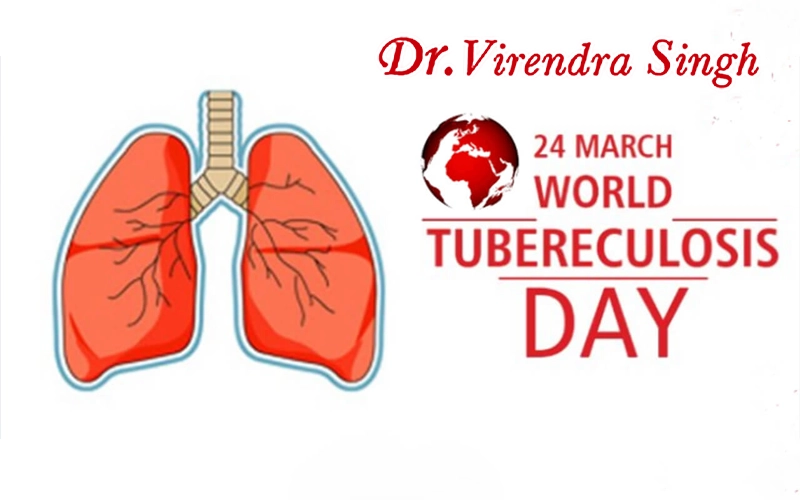
World Tuberculosis Day, observed annually on March 24th, marks a crucial moment for global health as it highlights the ongoing efforts to combat tuberculosis, a persistent and challenging infectious disease. This day provides an opportunity for addressing the worldwide tuberculosis pandemic by promoting cooperation, increasing awareness, and mobilizing resources. This annual event commemorates the date in 1882 when Dr. Robert Koch announced his discovery of Mycobacterium tuberculosis, the bacillus that causes tuberculosis (TB). The purpose of World TB Day is to raise public awareness of the global effects of tuberculosis.
An illness that has afflicted people worldwide since ancient times, tuberculosis (TB) is caused by the bacteria Mycobacterium tuberculosis. The bacteria majorly target the lungs but can also affect other organs such as the brain, Kidney and Spine. A contagious illness that may travel through the air is tuberculosis. Vaccination can partially prevent the sickness, although it can turn deadly in cases of severe infection or comorbidity. The World Health Organization established World Tuberculosis Day to raise awareness of the infectious illness that kills millions of people annually.
Dr. Virendra Singh, a distinguished expert in the field of pulmonology and infectious diseases, will be the guiding force on World Tuberculosis Day 2024. He is ideal for providing insightful commentary and leadership in the ongoing efforts to end TB because of his extensive knowledge and love for the disease. He is regarded as a thought leader in the medical field due to his dedication to furthering TB research, enhancing diagnostic techniques, and pushing for legislative improvements.
Dr. Virendra Singh’s guidance on World Tuberculosis Day will surely inspire and mobilize people, medical professionals, and policymakers to join forces in the fight against tuberculosis (TB), highlighting the significance of investment, innovation, and cooperative action to bring about positive change in the tuberculosis control and prevention landscape.
The Theme for World Tuberculosis Day 2024
The Theme of World Tuberculosis Day 2024 is ‘Yes! We Can End TB.’ It serves as a reminder that tuberculosis (TB) is one of the worst illnesses in the world and that the amount of cases of drug-resistant TB has been rising recently.
Significance of World Tuberculosis Day
As a celebration of the day in 1882 when Dr. Robert Koch revealed the discovery of the Mycobacterium tuberculosis bacterium, World Tuberculosis Day is extremely important in the battle against tuberculosis. This revolutionary discovery opened the door to a deeper comprehension of tuberculosis (TB) and established the groundwork for further investigation and therapeutic breakthroughs. The day serves as a reminder of the global community’s commitment to eliminating TB as a public health threat. It highlights the necessity of cooperative efforts between communities, healthcare institutions, and governments to address the obstacles presented by tuberculosis and move toward a world free of the disease.
Importance of World Tuberculosis Day
- Raising Awareness: The purpose of World TB Day is to increase public awareness of TB, its effects on both people and communities and the value of early identification and treatment. Increased awareness is key to reducing stigma, dispelling myths, and encouraging individuals to seek medical assistance promptly.
- Political Commitment: At the national and international levels, the day acts as a stimulus for political commitment. It inspires governments, decision-makers, and medical associations to recommit to combating tuberculosis, provide funds, and put into effect laws that fortify healthcare infrastructure.
- Community Engagement: World Tuberculosis Day encourages community involvement in TB prevention and control. A more thorough and efficient strategy for tuberculosis control may be accomplished by incorporating affected people, educating communities, and involving communities.
- Resource Mobilization: The day acts as a call to action for resource mobilization. Research, the creation of novel medicines, and the execution of effective TB control initiatives all depend on adequate financing. World Tuberculosis Day serves to enlist the aid of government organizations, charitable institutions, and the commercial sector.
Awareness Initiatives on World Tuberculosis Day
World Tuberculosis Day provides a focus for a variety of public awareness campaigns that try to enlighten the public, dispel myths, and instill a feeling of accountability. Some key awareness initiatives include:
- Educational Campaigns: NGOs, health organizations, and governments conduct educational campaigns to disseminate information about TB, its symptoms and methods of prevention. These campaigns attract a wide audience by using a variety of media platforms.
- Community Events: Local events such as workshops, seminars, and health fairs are organized to engage communities directly. These gatherings offer opportunities for conversation, dispersal of educational resources, and free tuberculosis testing.
- Social Media Campaigns: Through the use of social media, awareness campaigns on sites like Facebook, Instagram, and Twitter seek to reach a worldwide audience. Hashtags, personal stories, and infographics contribute to a broader understanding of TB-related issues.
- Medical Camps: Medical camps are erected in some areas to offer free TB testing, consultations, and information sharing. These camps bring healthcare services directly to communities, promoting accessibility.
Challenges in Tackling TB
The global attempts to eradicate tuberculosis are hampered by several kinds of obstacles, despite notable progress:
- Drug-Resistant Strains: One major concern is the growth of drug-resistant strains, including extensively drug-resistant (XDR-TB) and multidrug-resistant (MDR-TB) TB. Treating those forms of TB requires more prolonged and complex interventions.
- Socioeconomic Factors: Inadequate healthcare, hunger, and poverty are strongly associated with tuberculosis. To prevent and manage tuberculosis (TB), it is imperative to address social factors; yet, this calls for comprehensive measures that extend beyond medical interventions.
- Stigma and Discrimination: The stigma attached to tuberculosis (TB) can cause delays in seeking medical attention and impede attempts to stop the disease’s spread. Overcoming the social stigma surrounding TB is essential for promoting early detection and treatment.
- Global Migration: The international spread of tuberculosis is facilitated by increased migration and travel worldwide. International cooperation is required to solve the issues brought on by migration and stop the spread of tuberculosis across national borders.
Key Messages
- Investment in Tuberculosis Programs: TB initiatives need to be given top priority and more money from governments, international organizations, and the commercial sector. Adequate financial resources are essential to strengthen healthcare systems, ensure access to quality care, and support research for new TB interventions.
- Innovation in Diagnostic and Treatment: Developing novel diagnostic techniques and treatment plans is essential to enhancing tuberculosis control. A comprehensive plan to prevent tuberculosis must include both shorter and more effective treatment choices as well as rapid and precise diagnosis.
- Global Collaboration: TB knows no borders, and international collaboration is paramount in the fight against the disease. In collaborating to promote a unified front against tuberculosis (TB), nations, organizations, and researchers must exchange information, resources, and best practices.
- Community Engagement: It is essential to empower communities and include them in TB care and prevention. Increasing health-seeking behavior, lowering stigma, and raising knowledge are important ways to make sure people get timely and appropriate care.
- Advocacy for Policy Change: Governments play a pivotal role in creating policies that support TB control. The main goals of advocacy should be to improve health systems, influence legislation, and encourage a multisectoral strategy to address the socioeconomic drivers of tuberculosis.
FAQs
Why is World Tuberculosis Day observed on March 24?
On March 24, we celebrate World TB Day, which marks the day in 1882 when Dr. Robert Koch reported the discovery of the Mycobacterium TB bacteria.
What is the theme of World Tuberculosis Day 2024?
The theme for World Tuberculosis Day 2024 is ‘Yes! We Can End TB.’
How can individuals contribute to TB awareness?
By educating themselves and others about tuberculosis (TB), busting myths and misunderstandings, supporting TB-related projects, and advocating for early identification and treatment, individuals may help raise awareness of TB.
What is the current global burden of TB?
According to the World Health Organization (WHO), an estimated 10 million people fell ill with TB in 2020, and 1.5 million died from the disease, making it one of the top ten causes of death worldwide.
Can TB be prevented?
TB can be prevented through vaccination (BCG vaccine), early detection, and appropriate treatment. It’s also critical to address socioeconomic variables like hunger and poverty to avoid tuberculosis.
Is TB curable?
TB is curable with proper and timely treatment. Conventional tuberculosis therapy is taking a series of antibiotics for a certain amount of time. Early detection and completion of the full course of treatment are essential for a successful cure.
What role does innovation play in the fight against TB?
Innovation is critical in developing new tools, diagnostic, and treatment options for TB. Scientific and technological progress leads to quicker and more precise diagnosis, shorter and more efficient treatment plans, and the creation of vaccinations. Innovation is key to overcoming the challenges associated with TB control and prevention.
How can countries collaborate to address the global TB burden?
Global collaboration is essential to address the TB burden. Through exchanging information, resources, and best practices, countries may work together to support research projects, coordinate efforts to improve health systems and support research initiatives.
